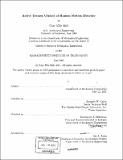| dc.contributor.advisor | Kenneth W. Kaiser and Mandayam A. Srinivasan. | en_US |
| dc.contributor.author | Hall, Gary Ellis, 1976- | en_US |
| dc.contributor.other | Massachusetts Institute of Technology. Dept. of Mechanical Engineering. | en_US |
| dc.date.accessioned | 2006-11-06T18:14:08Z | |
| dc.date.available | 2006-11-06T18:14:08Z | |
| dc.date.copyright | 2001 | en_US |
| dc.date.issued | 2001 | en_US |
| dc.identifier.uri | http://hdl.handle.net/1721.1/34343 | |
| dc.description | Thesis (S.M.)--Massachusetts Institute of Technology, Dept. of Mechanical Engineering, 2001. | en_US |
| dc.description | Includes bibliographical references (p. 141-142). | en_US |
| dc.description.abstract | All humans are subject to a physiological phenomenon known as tremor, which introduces unintended, relatively high-frequency movements into various parts of the body. These unintended movements serve to limit human motor performance with respect to normal human performance (for cases in which tremor is severe), and with respect to tasks that require "superhuman" performance (for cases in which not even normal tremor is tolerable). For example, the elderly often experience reduced motor control to the point where they can not eat. Similarly, surgeons performing eye surgery must have very little tremor to enable them to operate on the small anatomy of the eyes. In both cases, a motion disorder known as essential tremor can be the cause of the insufficient level of human motor performance. Current treatments for tremor disorders such as essential tremor include a small set of extremes (brain surgery versus doing nothing), with very little "middle ground." A device that could easily be placed onto the body and removed when not needed could fill this niche nicely. Due to the potential for high performance and portability, a new type of tremor stabilizer is proposed that uses a proof mass actuation scheme. This prototype device intended to attenuate human essential tremor along two translational axes was designed, constructed, and tested. Mechanical design, dynamics, and control systems modeling were performed, and the end device built to specifications. A shaker and experimental mount were constructed to artificially simulate tremor, and all data were gathered using this setup. The prototype demonstrated a 4:1 reduction in simulated tremor acceleration power from open- to closed-loop operation, as well as a 2:1 reduction in simulated tremor amplitude from open- to closed-loop operation. Medical personnel at Massachusetts General Hospital have suggested that this level of tremor attenuation would be helpful for their patients. Results were limited to vibrations along one of the two translational axes. Limitations of the prototype are discussed, as well as design strategies to improve performance in future work. | en_US |
| dc.description.statementofresponsibility | by Gary Ellis Hall. | en_US |
| dc.format.extent | 142 p. | en_US |
| dc.format.extent | 7594548 bytes | |
| dc.format.extent | 7600485 bytes | |
| dc.format.mimetype | application/pdf | |
| dc.format.mimetype | application/pdf | |
| dc.language.iso | eng | en_US |
| dc.publisher | Massachusetts Institute of Technology | en_US |
| dc.rights | M.I.T. theses are protected by copyright. They may be viewed from this source for any purpose, but reproduction or distribution in any format is prohibited without written permission. See provided URL for inquiries about permission. | en_US |
| dc.rights.uri | http://dspace.mit.edu/handle/1721.1/7582 | |
| dc.subject | Mechanical Engineering. | en_US |
| dc.title | Active tremor control of human motion disorder | en_US |
| dc.type | Thesis | en_US |
| dc.description.degree | S.M. | en_US |
| dc.contributor.department | Massachusetts Institute of Technology. Department of Mechanical Engineering | |
| dc.identifier.oclc | 48914944 | en_US |
